Intro
Manage gout symptoms with a balanced diet. Discover gout diet recommendations, including food triggers, purine intake, and nutrition tips to alleviate joint pain and inflammation, promoting a healthy lifestyle and gout prevention.
Gout is a type of arthritis that causes sudden and severe attacks of pain, swelling, and redness in the joints, often occurring at the base of the big toe. It is caused by an excess of uric acid in the blood, which can be triggered by a variety of factors, including diet, genetics, and certain medical conditions. While there is no cure for gout, a well-planned diet can help manage the condition and reduce the frequency and severity of attacks. In this article, we will explore the importance of diet in managing gout and provide recommendations for a gout-friendly diet.
A gout diet is designed to help reduce uric acid levels in the blood and prevent future attacks. It involves making lifestyle changes, including dietary modifications, to help manage the condition. The goal of a gout diet is to reduce the intake of foods that can trigger gout attacks and increase the consumption of foods that can help alleviate symptoms. By making informed food choices, individuals with gout can help manage their condition and improve their overall health.
Gout is a complex condition, and diet is just one aspect of managing it. However, a well-planned diet can play a crucial role in reducing the frequency and severity of gout attacks. Certain foods can trigger gout attacks by increasing uric acid levels in the blood, while others can help reduce inflammation and alleviate symptoms. By understanding which foods to avoid and which to include in their diet, individuals with gout can take a proactive approach to managing their condition.
Gout Diet Basics
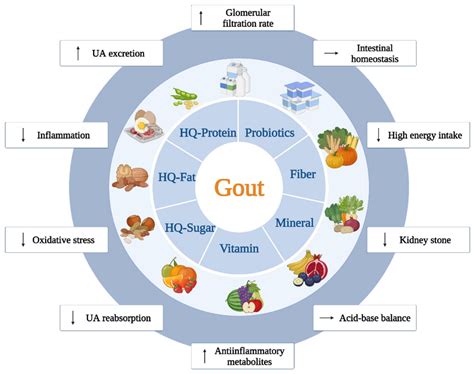
Understanding Purines
Purines are substances that are found in certain foods and can increase uric acid levels in the blood. They are broken down into uric acid in the body, which can trigger gout attacks. Foods that are high in purines include: * Organ meats, such as liver and kidney * Seafood, such as anchovies and sardines * Certain types of meat, such as beef and pork * Foods that are high in sugar, such as sweets and sugary drinks It is essential to limit the intake of these foods to reduce the risk of gout attacks.Foods to Avoid

Foods to Include
A gout diet should include plenty of foods that are low in purines and can help reduce inflammation and alleviate symptoms. These include: * Fruits, such as cherries and berries * Vegetables, such as leafy greens and bell peppers * Whole grains, such as brown rice and quinoa * Low-fat dairy products, such as milk and yogurt * Lean proteins, such as chicken and fish * Healthy fats, such as olive oil and avocado These foods can help reduce inflammation and alleviate symptoms, making it easier to manage gout.Benefits of a Gout Diet
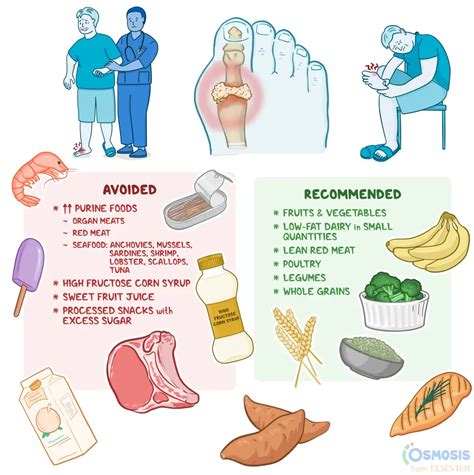
Creating a Gout Meal Plan
Creating a gout meal plan can help individuals with gout make informed food choices and manage their condition. A gout meal plan should include a variety of foods that are low in purines and can help reduce inflammation and alleviate symptoms. Here are some tips for creating a gout meal plan: * Include plenty of fruits, vegetables, whole grains, and low-fat dairy products * Choose lean proteins, such as chicken and fish * Limit the intake of foods that are high in purines, such as organ meats and seafood * Avoid foods that are high in sugar and saturated and trans fats * Drink plenty of water to stay hydratedGout Diet and Lifestyle Changes
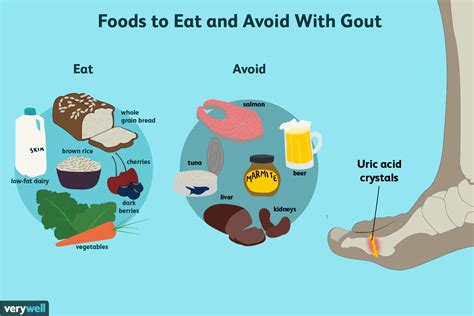
Gout Diet and Medication
In some cases, individuals with gout may need to take medication to manage their condition. A gout diet can be used in conjunction with medication to help manage gout. It is essential to talk to a healthcare provider before making any changes to your diet or medication regimen.Common Gout Diet Mistakes
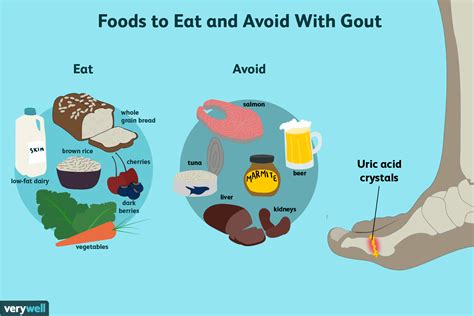
Gout Diet and Nutrition
A gout diet should be well-planned and balanced to ensure that individuals with gout are getting all the nutrients they need. Here are some tips for getting the right nutrients: * Eat a variety of fruits and vegetables * Choose whole grains, such as brown rice and quinoa * Include low-fat dairy products, such as milk and yogurt * Choose lean proteins, such as chicken and fish * Healthy fats, such as olive oil and avocado, can help reduce inflammationGout Diet Resources
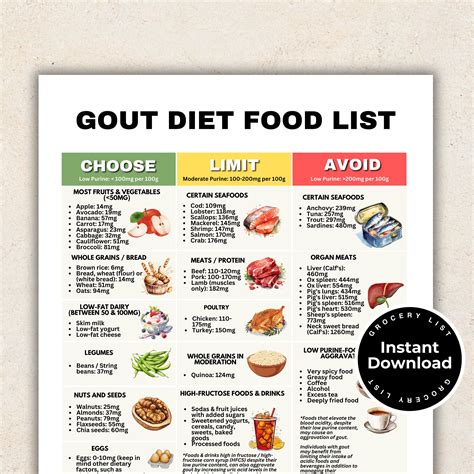
Gout Diet and Research
Research has shown that a well-planned gout diet can help reduce the frequency and severity of gout attacks. Studies have found that diets that are low in purines and high in fruits, vegetables, and whole grains can help reduce uric acid levels in the blood and alleviate symptoms. By staying up-to-date with the latest research, individuals with gout can make informed decisions about their diet and lifestyle.What are the best foods to eat for gout?
+Foods that are low in purines and high in antioxidants, such as fruits, vegetables, and whole grains, can help reduce inflammation and alleviate symptoms.
What are the worst foods to eat for gout?
+Foods that are high in purines, such as organ meats and seafood, can trigger gout attacks. Foods that are high in sugar and saturated and trans fats can also exacerbate symptoms.
Can a gout diet help reduce the frequency of gout attacks?
+Yes, a well-planned gout diet can help reduce the frequency and severity of gout attacks by reducing uric acid levels in the blood and alleviating symptoms.
How long does it take to see results from a gout diet?
+Results from a gout diet can vary, but many individuals with gout see improvements in their symptoms within a few weeks of making dietary changes.
Can I still eat my favorite foods on a gout diet?
+While it's best to limit or avoid foods that are high in purines, it's not necessary to completely eliminate your favorite foods. Moderation is key, and finding healthier alternatives can help you stick to your diet.
In conclusion, a well-planned gout diet can play a crucial role in managing gout and reducing the frequency and severity of gout attacks. By understanding which foods to avoid and which to include in their diet, individuals with gout can take a proactive approach to managing their condition. With the right resources and support, individuals with gout can create a diet that helps them manage their symptoms and improve their overall health. We encourage you to share your experiences with gout and diet in the comments below, and to reach out to a healthcare provider or registered dietitian for personalized guidance on creating a gout-friendly diet.
